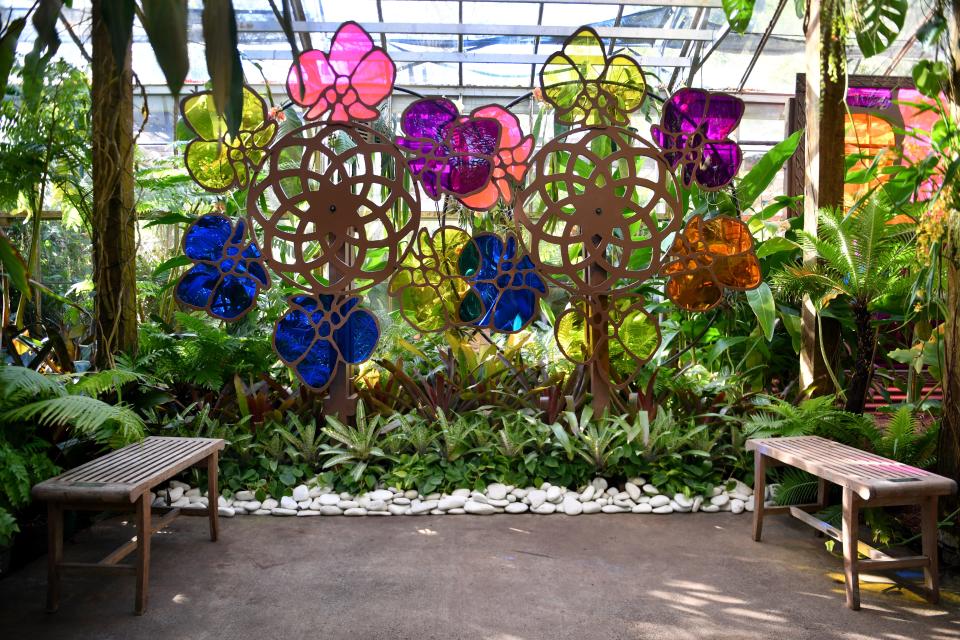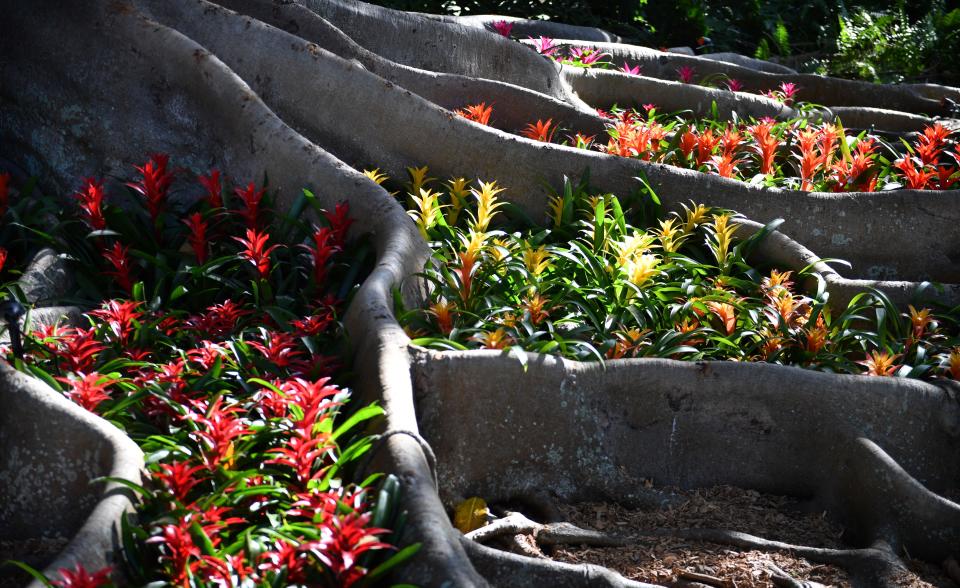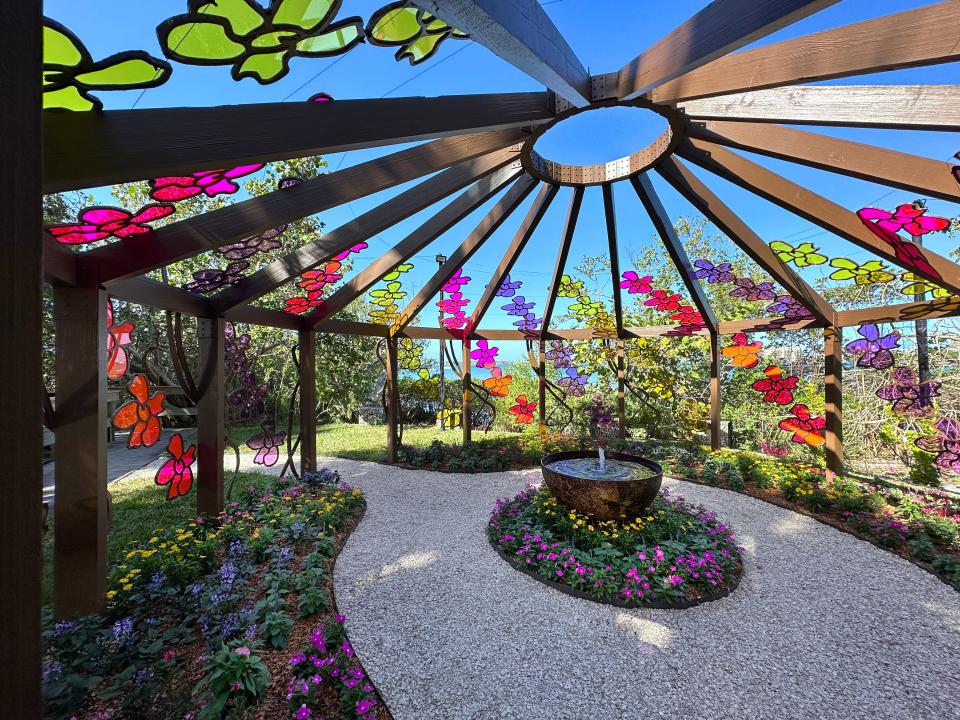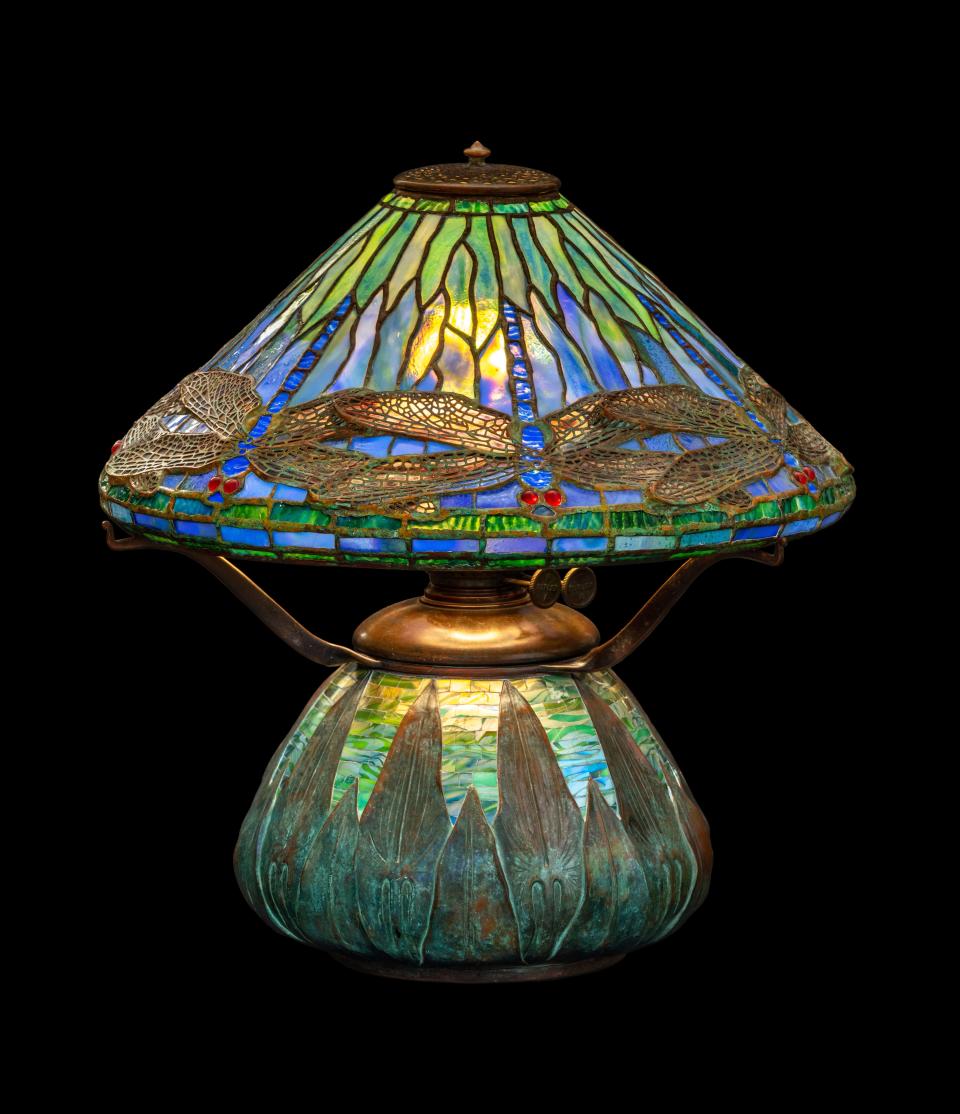Art imitates life and vice versa in Selby Gardens’ Tiffany exhibition
- Oops!Something went wrong.Please try again later.
Do you believe in magic?
Artists typically draw inspiration from the stuff their dreams are made of. Wood, stone, paper, cloth – the material’s character informs the artist’s creation. Typically.
Louis Comfort Tiffany did the opposite. He created stunning natural forms, including butterflies, dragonflies, orchids, and irises. But he worked with glass – a lattice of silicon atoms. It’s sterile, inorganic stuff. In a kind of artistic alchemy, Tiffany used it to evoke nature’s beauty. Quite a magic trick.
“Tiffany: The Pursuit of Beauty in Nature” illuminates his transformative artistry at Selby Gardens. The exhibition’s design is the brainchild of David Berry, the Gardens’ chief museum curator, and Nathan Burnaman, its associate director of horticultural exhibits, in collaboration with horticulturists Mike McLaughlin and Angel Lara. Where Tiffany pursued nature’s beauty with glass and lead, they reflect his beautiful imagery with living plants and colored acrylic panels. These vignettes change your perception of the Gardens. That’s also magical.
Arts Newsletter: Sign up to receive the latest news on the Sarasota area arts scene every Monday
Theater, dance, music, art and more: 50-plus arts events to see and hear in March in Sarasota-Manatee area
Transforming a garden: A window into the world of Tiffany glass on display at Selby Botanical Gardens

Coloring Perceptions
The vignettes begin at the Tropical Conservatory. Inside, orchids, bromeliads and begonias bloom in living color. The Gardens’ talented creators echo nature’s colorful complexity with their Tiffany-inspired creations. Flowers blossom in stained glass windows, or droop from the rafters like transparent air plants. A rotating “Color Wheel” creates an ever-changing light show. The transparent facets of these pieces look like stained glass, although they’re actually made of colored acrylic. Their opalescent color is a nod to what Tiffany’s trademarked Favrile process. The artist didn’t simply stain his glass; he embedded color in the process of making the mosaic elements.

Pursuing Beauty on the Garden Path
Outside, the path takes a lazy curve to Sarasota Bay. Along the way, Tiffany-style vignettes make a perfect counterpoint to natural beauty.
“Rooted in Nature” makes clever use of the negative spaces between the roots of a sprawling Moreton Bay fig tree near the Children’s Rainforest Garden. The creators thought the roots resembled the lead traceries of a stained glass window. Here, they planted the gaps between them with colorful Guzmania flowers instead of glass.
“Succulents in Silhouette” flanks the path along the Succulent Garden with a series of colored acrylic panels resembling stained glass windows. Each “window” repeats the stylized silhouette of a century plant with different colors. The sun shines through, making patterns of purple, orange, blue, green. Depending on the time of day, the lightshow hits the garden or the path.

The “Living Lampshade” looks like a Tiffany lampshade designed for a 60-foot lamp. Enlarged to this scale, the structure resembles a 16-sided psychedelic gazebo. It repeats a floral motif in translucent shades of blue, green, orange, and red. The flower is an orchid — a nod to the Gardens’ symbol and claim to fame in botanical research.
“Sunset on Palms” creates a beautiful sense of double vision. The creators (cognizant of perspective) created a vignette of Tiffany-style palms against a backdrop of living palm trees. If you stand in a certain spot, it all comes together. Nature and art’s imitation are perfectly superimposed.
“Flowing Flower” simulates the leading of a Tiffany wildflower design with rivulets of running water. The vignette’s lush greenery is alive. The flower’s “petals” are created with stones and shards of colored glass.
Touring historic buildings: Architect Victor Lundy turns 100. See seven of his landmark Sarasota buildings
A Tony-winning musical: Manatee Players stand ‘Side by Side’ for Stephen Sondheim’s musical ‘Company’
Review: Tennis stars battle through life issues for a tournament win in FST’s ‘Last Match’

Color my World
The path ultimately leads to Selby Gardens’ Museum of Botany & the Arts. The Gardens’ vignettes are living imitations of Tiffany’s art. Inside the museum, you see the thing itself.
The “Daffodil Lamp” (early 1900s) has an intricate, stylized hanging shade of leaded glass. The lampshade of the “Dragonfly Lamp” (ca. 1906) sports dive-bombing dragonflies with intricate wings and jewel-like eyes. “The Clematis Vine Window” (ca. 1906) is a stained glass window laced with delicate (but scientifically accurate) clematis vines
These and the other 42 pieces are all credited to Tiffany Studios, not the individual artist. You learn that Tiffany was both an artist and an entrepreneur. He’s typically associated with the Aesthetic movements. “Art for art’s sake,” was its motto. But Tiffany’s art was art for commerce’s sake. Louis Comfort Tiffany’s father, Charles Lewis Tiffany, had founded Tiffany and Company, the jewelers of “Breakfast at Tiffany’s” fame. Tiffany Studios was his claim to fame.
Despite his talent, Tiffany couldn’t create enough lamps and stained glass pieces to satisfy demand. He needed a team. The “Tiffany Girls” made it possible. They were a studio of female artists and artisans, who not only fabricated pieces, but invented original designs. They pursued nature, all right. (The “Dragonfly Lamp” was probably Clara Driscoll’s concept.) The museum shows examples of the botanical illustrations and samples they used as references.
Tiffany and his studio artists honored the beauty of life in their pieces; Selby Gardens’ horticultural artists honored their legacy in their vignettes. The creators of yesterday and today pursued the beauty of nature and art.
Thanks to the power of imagination, their chase succeeds.
‘Tiffany: The Pursuit of Beauty in Nature’
Runs through June 25 at Marie Selby Botanical Gardens, 1534 Mound St., Sarasota. 941-366-5731; selby.org
This article originally appeared on Sarasota Herald-Tribune: Tiffany stained glass inspires colorful plant display at Selby Gardens

